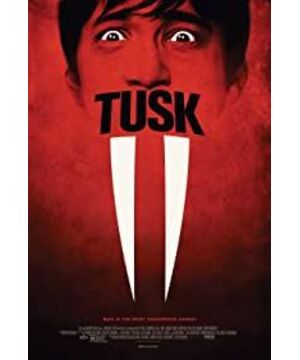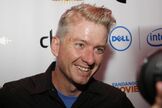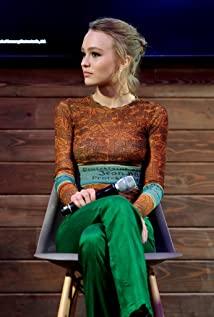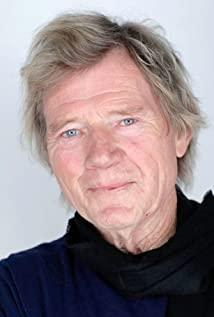The human-shaped walrus, as the name implies, transforms a person into a walrus. This is not just staying at the superficial level of "playing an animal," but through changes or transformations in body shape and mental emotions, allowing people to complete "animal role play" [Note 1]; moreover, directly transforming into an animal. "Human Walrus" is not the first thriller that transforms humans into animals. The Human Centipede (First Sequence) (2009) made an attempt many years ago to challenge the limits of the audience's fear. Such a subject may seem shocking at first glance, but "transformation" has long been a common theme in mythological works. For example, Zeus once became a swan in order to get close to the person he admired. Until modern times, in "The Metamorphosis" (Die Verwandlung, 1915) by Franz Kafka (1883-1924), the protagonist transformed into a giant beetle straight away. Not only that, but Miyazaki's animations often see the deformation between humans and animals. The transformation of human beings into animals, on the one hand, is able to break away from the standard of "human" and take the opportunity to criticize external society and human nature. On the other hand, transfiguration also means surpassing the clear and distinct boundary between "humans/animals (beasts)", revealing the close relationship between humans and animals, or even directly revealing that humans are also an animal. This is a fact that humans, who claim to be the spirit of all things, strongly deny. It is because we are used to describing the negative human nature as animals, just like the term "human face and animal heart" clearly defines the high and low classes of humans and animals. However, this boundary has never been indestructible, as Hao Erhao (Michael Parks) said: "Monsters have always existed in people's hearts." I think the reason why "Human Walrus" is terrifying, or making people feel uncomfortable, actually comes from Director Kevin Smith has severely trampled on the "human/animal" boundary. The movie describes Wallace (Justin Long), an American webcast host, who went to Canada alone in search of strange things. He unexpectedly found a flyer that made him become Hao Erhao's prey. After receiving the distress message, Wallace’s girlfriend Allie (Genesis Rodriguez) and host partner Teddy (Haley Joel) Osment) set out together to find Wallace's whereabouts. However, when they finally found Wallace, he/it had already become a human-shaped walrus. Wallace’s transformation has its origins. Although the director did not present the complete process in detail, it is not difficult to imagine how he carefully planned it in Hale from the many anatomical drawings of the human body and the blood-stained surgical equipment. Next, through a surgical operation, a person is transformed into a walrus. From the time Wallace was stunned by Haw's medicine, until he lost a leg and eventually became a walrus, the whole process demonstrated that his subjectivity as a human being was deprived one by one, and then he lost his autonomy and became an animal that must rely on feeding for his livelihood. In this relationship, Hauer seems to dominate Wallace, but in fact, he is just recreating his tragic childhood. Hao Er, who became an orphan after losing his mother, is an object/tool used by everyone. Whether it is a politician or a priest, they have used Hall's orphan status to defraud him for welfare, seek fame, or vent his sexual desires on him. Haoer described them as "sodoma". On the one hand, he meant it literally. On the other hand, it also meant that his sovereignty as a human being was trampled upon and raped. The director created a tragic childhood for Haw and laid the foundation for his later abnormal behavior. This also reflects people's imagination of murderers: there must be some "reason" to create an inhuman monster. With reasons, these threatening monsters can be smoothly classified as "others"; more importantly, these reasons are enough to comfort people's hearts, because the so-called monsters do not exist in the first place, but are "made". In other words, as long as we can completely eliminate the requirements for making monsters, there are ways to prevent their birth. But Hal didn't think so. He believes that "human beings are a vast ocean of waste," in addition to being "savage creatures." In his eyes, humans are monsters, and monsters are humans. There is no difference between animals and humans. As an adult, Hauer went on adventures everywhere. During a voyage, he unfortunately encountered a shipwreck and drifted to a deserted island. Fortunately, he was protected from freezing to death under the shelter of the walrus. However, in order to survive, he has become friends with the walrus and named it "Longfang". Mr." (Mr. Tusk's Haul, finally killed the walrus and bound his belly. This experience left a lifelong shadow in Haul's heart, but it also made him realize a truth: if you want to survive, you must become a beast. Haul, who had been treated by brutal and inhumane acts, eventually became a savage; even for atonement, he became a terrifying serial killer. Hauer's transformation is embarrassing. At the same time, after he regarded the walrus as "God's highest creation," he not only reversed the position of "human/animal", but also blurred its boundaries. Therefore, it is not so much that Haw "made" Wallace as a walrus, but rather that he was practicing his insight. No wonder the director deliberately gave Wallace a name that sounds similar to walrus, because "human/animal" is just two sides of him. As a webcast host, Wallace, like today’s media, always likes to attract audiences with curious angles and sensational topics, just like the bloody video of "Chasing Bill Kid" at the beginning of the movie and the miserable state of extreme happiness. The material that he said and laughed. If you misappropriate Hauer's statement, Wallace is a "sodter" who consumes the suffering of others to satisfy his own pursuit of fame and fortune. Therefore, even though Wallace still maintained a human appearance at this time, he was already a savage animal in his heart. Hal's operation was only to completely concretize this fact. What’s interesting is that when Wallace turned into a human-shaped walrus, there were still plastic cups for cold drinks in convenience stores—a symbol of human civilization—as if to remind him of the fact that he was a human; or, in other words, plastic cups. The existence of Wallace prevents Wallace from completely transforming into an animal, allowing the ambiguity of "human/animal" to be preserved. Hauer said: "If you want to live, then become a walrus, otherwise you are waiting to die." At the end of the story, Wallace, who survived, was drawn out of a hole by the mackerel that Ellie had dropped, tearing the fish to eat. Is it an animal? Allie thought that crying was the basis for distinguishing between humans and animals, and Wallace did shed tears, so is he a human? Perhaps there has never been any boundary between the two. [Note 1] Kaweibo, a professor at the Institute of Philosophy, Central University, Taiwan, once said in the article "Human Models: The Origin of SM, Mystery, and Others": "But "playing animals" is different from "role-playing animals." The latter involves psychology, attitude, identity, emotion, habits, language, interaction (relationship), physical changes or transformation in varying degrees, rather than staying at the external level." Tusk's Haul, finally killed the walrus and bound his belly. This experience left a lifelong shadow in Haul's heart, but it also made him realize a truth: if you want to survive, you must become a beast. Haul, who had been treated by brutal and inhumane acts, eventually became a savage; even for atonement, he became a terrifying serial killer. Hauer's transformation is embarrassing. At the same time, after he regarded the walrus as "God's highest creation," he not only reversed the position of "human/animal", but also blurred its boundaries. Therefore, it is not so much that Haw "made" Wallace as a walrus, but rather that he was practicing his insight. No wonder the director deliberately gave Wallace a name that sounds similar to walrus, because "human/animal" is just two sides of him. As a webcast host, Wallace, like today’s media, always likes to attract audiences with curious angles and sensational topics, just like the bloody video of "Chasing Bill Kid" at the beginning of the movie and the miserable state of extreme happiness. The material that he said and laughed. If you misappropriate Hauer's statement, Wallace is a "sodter" who consumes the suffering of others to satisfy his own pursuit of fame and fortune. Therefore, even though Wallace still maintained a human appearance at this time, he was already a savage animal in his heart. Hal's operation was only to completely concretize this fact. What’s interesting is that when Wallace turned into a human-shaped walrus, there were still plastic cups for cold drinks in convenience stores—a symbol of human civilization—as if to remind him of the fact that he was a human; or, in other words, plastic cups. The existence of Wallace prevents Wallace from completely transforming into an animal, allowing the ambiguity of "human/animal" to be preserved. Hauer said: "If you want to live, then become a walrus, otherwise you are waiting to die." At the end of the story, Wallace, who survived, was drawn out of a hole by the mackerel that Ellie had dropped, tearing the fish to eat. Is it an animal? Allie thought that crying was the basis for distinguishing between humans and animals, and Wallace did shed tears, so is he a human? Perhaps there has never been any boundary between the two. [Note 1] Kaweibo, a professor at the Institute of Philosophy, Central University, Taiwan, once said in the article "Human Models: The Origin of SM, Mystery, and Others": "But "playing animals" is different from "role-playing animals." The latter involves psychology, attitude, identity, emotion, habits, language, interaction (relationship), physical changes or transformation in varying degrees, rather than staying at the external level." Tusk's Haul, finally killed the walrus and bound his belly. This experience left a lifelong shadow in Haul's heart, but it also made him realize a truth: if you want to survive, you must become a beast. Haul, who had been treated by brutal and inhumane acts, eventually became a savage; even for atonement, he became a terrifying serial killer. Hauer's transformation is embarrassing. At the same time, after he regarded the walrus as "God's highest creation," he not only reversed the position of "human/animal", but also blurred its boundaries. Therefore, it is not so much that Haw "made" Wallace as a walrus, but rather that he was practicing his insight. No wonder the director deliberately gave Wallace a name that sounds similar to walrus, because "human/animal" is just two sides of him. As a webcast host, Wallace, like today’s media, always likes to attract audiences with curious angles and sensational topics, just like the bloody video of "Chasing Bill Kid" at the beginning of the movie and the miserable state of extreme happiness. The material that he said and laughed. If you misappropriate Hauer's statement, Wallace is a "sodter" who consumes the suffering of others to satisfy his own pursuit of fame and fortune. Therefore, even though Wallace still maintained a human appearance at this time, he was already a savage animal in his heart. Hal's operation was only to completely concretize this fact. What’s interesting is that when Wallace turned into a human-shaped walrus, there were still plastic cups for cold drinks in convenience stores—a symbol of human civilization—as if to remind him of the fact that he was a human; or, in other words, plastic cups. The existence of Wallace prevents Wallace from completely transforming into an animal, allowing the ambiguity of "human/animal" to be preserved. Hauer said: "If you want to live, then become a walrus, otherwise you are waiting to die." At the end of the story, Wallace, who survived, was drawn out of a hole by the mackerel that Ellie had dropped, tearing the fish to eat. Is it an animal? Allie thought that crying was the basis for distinguishing between humans and animals, and Wallace did shed tears, so is he a human? Perhaps there has never been any boundary between the two. [Note 1] Kaweibo, a professor at the Institute of Philosophy, Central University, Taiwan, once said in the article "Human Models: The Origin of SM, Mystery, and Others": "But "playing animals" is different from "role-playing animals." The latter involves psychology, attitude, identity, emotion, habits, language, interaction (relationship), physical changes or transformation in varying degrees, rather than staying at the external level." . Is it an animal? Allie thought that crying was the basis for distinguishing between humans and animals, and Wallace did shed tears, so is he a human? Perhaps there has never been any boundary between the two. [Note 1] Kaweibo, a professor at the Institute of Philosophy, Central University, Taiwan, once said in the article "Human Models: The Origin of SM, Mystery, and Others": "But "playing animals" is different from "role-playing animals." The latter involves psychology, attitude, identity, emotion, habits, language, interaction (relationship), physical changes or transformation in varying degrees, rather than staying at the external level." . Is it an animal? Allie thought that crying was the basis for distinguishing between humans and animals, and Wallace did shed tears, so is he a human? Perhaps there has never been any boundary between the two. [Note 1] Kaweibo, a professor at the Institute of Philosophy, Central University, Taiwan, once said in the article "Human Models: The Origin of SM, Mystery, and Others": "But "playing animals" is different from "role-playing animals." The latter involves psychology, attitude, identity, emotion, habits, language, interaction (relationship), physical changes or transformation in varying degrees, rather than staying at the external level."
View more about Tusk reviews











